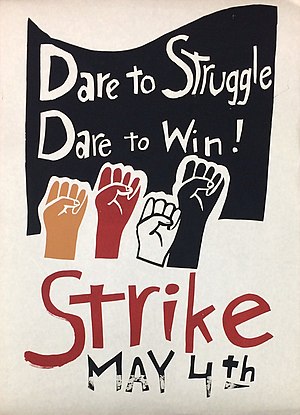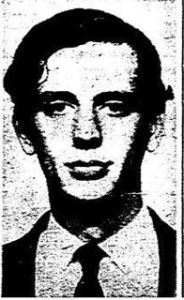Ohio University
On May 4, 1970, an estimated 3,000 Ohio University (OU) students met to discuss the possibility of a peaceful strike on the Athens campus in response to the invasion of Cambodia and the Kent State shootings. 2,500 students voted in favor of the strike. The same day Taylor Culbert, Vice President of Academic Affairs, read aloud a speech to the gathered students written by OU President Claude Sowle. In his remarks, Sowle spoke in favor of peaceful discussions at OU and offered to help facilitate them. Still, he made it clear that the administration would not tolerate acts of violence. [13]
On May 5, the student strike began. 4,000 students took part in a rally in the Grover Center. The two main speakers at the rally were President Sowle and life photographer Gordon Parks. Sowle praised the protesters for the lack of violence, but he said he would not close down the university for the strike. He stated, “We will protect the freedom of those who want to go to class. The University has a responsibility to protect the rights of those students who wish to attend class as much as your right not to attend classes.” The students at the rally agreed to hold a “March Against Death” the following day. [14]
On May 6, over 2,500 people participated in a “March Against Murder”. It began on the College Green and traveled past the Athens County Selective Service Office and the National Guard Armory. The peaceful protest “marked the climax of a two-day ‘student strike’ on campus.” Following the march, students held sit-ins and marches on Athens streets. At night, another mass meeting of some 3,000 people was held to determine what, if any, further protests should be held but no consensus was reached. In a statement, President Sowle expressed support for the peaceful protests and said he was “confident” OU would remain open. “Each student,” stated Sowle, “must express his concern in whatever way he deems appropriate. However, we must leave the opportunity for those who want to attend class.” [15]
On May 7, the protests grew more confrontational and violent. Students occupied Athens businesses, nearly thirty of which closed. There was a firebombing at the ROTC supply room in Peden Stadium, which caused an estimated $4,000 damage. FBI investigators were called in to investigate the firebombing. There was also a bomb threat that led to the evacuation of Woolworths. At the same time, hundreds of students peacefully gathered on campus throughout the day and night. [16]
On May 8, twenty-five students from the newly formed Committee on Issues and Action (COIA) met with President Sowle at the university airport after he returned from Washington where he appeared on a national television program on Vietnam and campus protests. The students wanted to find ways to keep the university open but still have peaceful protests and discussions. The president said that he was “glad” that the COIA requested the meeting and that they would meet again in the next twenty-four hours. Also, students tried to get Athens businesses to close. Most of the businesses they approached were already closed. However, the BBF restaurant refused to close, so about 100 students participated in a sit-in. An OU professor who was in the restaurant asked the students, “What is to gain by shutting down the stores. Your intimidation is a form of violence.” The students eventually left the restaurant and made a couple more stops before being met by the police who asked the students to return to the College Green, where students continued to gather until late at night. [17]
On Saturday, May 10, COIA members met with President Sowle about cancelling classes on Tuesday for a campus discussion on national problems, but he refused to do so. The administration also banned two out of three speakers scheduled to speak at a rally sponsored by the Athens Peace Committee (APC), which was to be held at the Grover Center on Monday night. Sowle later allowed the two to speak. [18]
On May 11, an outbreak of more violence threatened to close the university. After the APC held a mass rally at the Grover Center, a group of about seventy-five students forced their way into the Chubb Library, occupied it, and issued a list of demands. The list included the end of ROTC and other expressions of the “war machine” on campus. The students remained in the building throughout the night. The same night someone firebombed the Nelson Commons cafeteria causing more than $100,000 dollars in damage. It took the Athens fire department an hour to put the fire out. Someone also started a trash fire in the basement in the South Green dormitory. [19]
By May 12, the ability to maintain peace on the campus was quickly deteriorating. There were bomb threats, trash fires, and false fire reports. A group of fifty students presented a list of proposals to President Sowle. They demanded he to act upon seven of their proposals, which called for new classes on “the military industrial complex” and other topics, within twenty-four hours or the students threatened to “close the University down physically since it is already closed down academically.” More than 100 student and faculty marshals were placed around the university with the specific instructions to watch for “suspicious characters and happenings.” Athens police banned the use of gasoline in containers in order to stop acts of arson. [20]
On the night of May 13, a group of about 350 students met at Baker Center to discuss President Sowle’s suspension of seven students for creating a “clear and present danger” on campus. The Faculty Senate passed a resolution to reinstate the students until a hearing could be held, but Sowle rejected it. After two hours of discussion, the group walked around the residence greens in a “solidarity march”. The group then moved to Cutler Hall, where rocks and bricks were thrown through building windows. Sowle tried to negotiate with the group but was shouted down and left after more rocks were thrown. The group tried to move into the downtown area but was met by Athens Police in riot gear. After rocks and bricks were thrown at the police, they responded by firing canisters of pepper gas. Confrontations between students and the police went on throughout the night. Seven students were arrested. [21]
In the early morning of May 15, President Sowle, following a second night of violence, announced the closing of Ohio University for the remainder of the term and requested the National Guard be sent to Athens. In recorded remarks, Sowle said it was “sad indeed that this inspiring period in the history of Ohio University must end in such an unfortunate way,” but he praised “the magnificent efforts of the great majority of faculty, students and staff to keep the University open. We tried, but we failed.” A few hours later, the first of 1500 National Guardsmen began to arrive in Athens. The violence started around 11:05pm when approximately 800 students broke away from a larger, campus gathering and attempted to move into the downtown area. Athens police fired tear gas at the group of students, and they fired rocks, bricks, and other objects at police and downtown stores. Many store windows were broken. Confrontations between police and students went on for several hours, and there was considerable damage. A university vehicle was firebombed and destroyed. There was also a small fire in a university lab. Windows on several university buildings were broken. Twenty-six students were treated for injuries. [22] In the words of one anonymous student protestor, “Ohio University had to close.” “It was necessary, almost inevitable, that the University close for the simple reason that for the last ten years students and others have been peacefully protesting the war in Vietnam and where has it got them—into Cambodia.” [23]
University of Virginia
Strike activities at UVA were highly attended, and led to traffic disruptions and arrests. Marching students halted traffic on highways 250 and 29, and during the worst of the strike, Mayflower moving vans were used as temporary holding cells for arrested protesters. On May 6, students, locals, and people who traveled from across Virginia gathered for a day of rallies at UVA, where state protests were now centered. [27] UVA President Edgar Shannon spoke to the crowd, and was pelted with marshmallows. [27] Shannon had been presented with a list of nine demands from the Student Council, led by its first African American president, James Roebuck. [27] That night, Yippie Jerry Rubin and civil-rights lawyer William Kunstler spoke to an audience of 8,000 at University Hall, a basketball arena not far from the university's historic center in Charlottesville, encouraging students to close down universities nationwide. [27]
On May 5, the University received an injunction to prevent students from occupying Maury Hall, the ROTC building; despite this, a small number of protesters remained there until a small fire broke out in the early hours of Thursday, May 7, forcing them to evacuate. [27] By Friday, May 8, the protests led to police action. [28] The strike had lasting consequences in the months that followed. Student reporting at the time argued that a new Alumni Association was being founded directly in response to strike supporters' activities in an effort to ensure that conservative donors continued to give to the university. [29]










